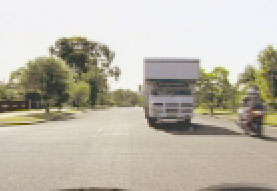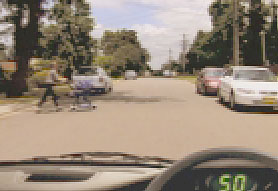The DQT (Driver Qualification Test) is the final test for new drivers in New South Wales to pass before they can progress from a P2 driver licence to a full unrestricted Silver or Gold licence.
After I passed the DQT I thought I’d publish all the official information I studied and tips from people who have done the test themselves which helped me pass, so that other people on their P2’s who want to pass the DQT can also benefit from it.
Here’s some background information about the test:
The Driver Qualification Test (DQT) is a touch-screen, computer-based test, made up of two parts:
Part 1 is a knowledge test that assesses your knowledge of road safety issues. It is based on information from road safety research about lowering crash risk, particularly for drivers with only a few years of driving experience. It will test your knowledge of all sections contained in the Driver Qualification Handbook.
Part 2 is a hazard perception test that assesses your ability to recognise hazards and respond appropriately. It is based on the driving situations that lead to the five most common crash types for new full licence holders in NSW.
The DQT is therefore a bit like a test made up an advanced version of the Driver Knowledge Test (DKT) that you passed to obtain your Learner licence, and the Hazard Perception Test (HPT) that you passed to obtain your P2 licence. However the DQT is more challenging than the DKT or the HPT. You will need to study the Driver Qualification Handbook carefully to help you pass.
You can attempt the DQT when you have held your Provisional P2 licence for a minimum of 24 months. However, you should not feel under any pressure to attempt the test immediately. You may continue to drive on your P2 licence for a further 6 months provided the licence remains current, or longer if the licence is renewed. You should only attempt the DQT when you are ready, that is when you have studied the Driver Qualification Handbook and applied the information to your driving.
- For starters you should download the DQT Handbook from the RMS website and study it well. The hand book is available in several languages including Chinese, Greek and Korean.
Going through the links at the Licence section on the RMS website is also highly recommended.
- Do the sample multiple choice questions test on the RMS website. The questions are similar to Part 1 of the DQT
- Do the practice Hazard Perception test on SA Government MyLicence. This will give you a really good idea of what to expect in the RMS DQT computer test
- As with most things you do these days, the RMS charges fees left right and centre for all the tests you do to move from L’s to P1 to P2 to a full driver’s licence. The only fee you can avoid is for handbooks (so make sure you use the free downloadable PDF copies) and the other fee you can minimise is for actually doing the various RMS tests because by studying well you can pass the first time and avoid having to pay to do the test over and over again which is quite expensive.
- To book your test you can go to any Call Service NSW but I recommend booking and paying for the DQT test online which is what I did so you can see all the available times at the centre you want to do your test at without having to wait in a call centre queue.

The following suggestions are from people who have done the DQT and discussed the questions on internet forums. The 2 pictures (from the DQT handbook) are typical examples of situations in the DQT Part 2 Hazard Perception Test where you have to be careful to react properly.
For example: in the first picture you shouldn’t turn right because the truck is blocking your view of oncoming traffic like the motorcyclist who suddenly appears from behind it. In the 2nd picture you have to be quick to react to pedestrians who decide to cross the road at the wrong place. In this case a women pushing a stroller.
Suggestions found on Internet Forums
username Nayfern – on forum.pulsar.org.au
I downloaded the book from the RTA site. You have to actually read the book because the first half of the test is theory questions. I would not have known some of these questions without reading the book. example of a couple of questions.
What rate does the percentage of having a crash go up by when you do 10kmh over a 60 kmh speed limit [need 30% more stopping distance]
[ For example, if you travel at 70 km/h in a 60 km/h zone your car will need 30 per cent more distance to brake to a stop than the other cars travelling at the 60 km/h speed limit.]
another question was; What is the percentage of killing a pedestrian if you hit them a 60 kmh, answer 70%.
You have to learn the most common crash types as well[human factors 57%, human & environmental factors 26%, vehicle and human 6%]
i dont know how any of this can make me drive a car better, doesn’t give me better car control or hazard skills.
The second half of the test was like the test to get from Red Ps to Greens, same press screen when you would turn or stop.
username newcastle – on cracker.com.au
Most of questions are common sense, but some of them need to remember the contents from the book, like how many seconds from finding a hazard to covering the brake
[0.75s to see hazard 7 make decision, 0.75 to brake = 1.5s total]what is the percentage of fatigue driving in city area,etc.
[25% in city, 75% in country + also
High-risk times for fatigue-related crashes are early morning between 4 am and 8 am and in the afternoon between 12 noon- 2 pm]
Usernames doodz, Matex, Krim, Demented Freak, Shamrock and BananaMan – on forums.overclockers.com.au
Instead of 3 answer multiple choice (When you do your Ls) it is 4 answer multiple choice. (1st section)
Most of the time you do not have to touch the screen. (For the 2nd section)Confirmed, at least read the summary section of the handout, the questions ask stuff about statistics. The video part you should be fine with.
Is it dangerous to overtake this car?’
(Note: You’re travelling at 105 because of the car in front, speed limit is 110, and a logging truck is coming the other way, do you challenge the logging truck at chicken at 110?)
Whatever you do make sure you break/touch the screen when its about a 5 sec gap. Dont leave it too late.
I did the test mid-January. Couple of tips are to be very cautious when it comes to the “When is it safe to turn at this intersection” questions, brake early when approaching the bend in the “When should you brake” question and press the screen to brake if you see a lady pushing a pram along side the road.
my theory is take 3-4 empty schooner glasses with you, stack them up and look through the bottom of the stack against the screen whilst doing the test, only turn where it looks safe, and if it’s hard to see what’s going on slow down…..
-See a suicidal lady with pram – slow down.
-See a corner sign on country road – slow down
-Don’t turn right, just sit and wait. I had like 8 in a row and it wasn’t safe to go on any of them
I hope everyone passes first time 🙂
When you do pass make sure you have enough cash or enough limit left on your credit card to pay for a Gold 5 year or 10 year licence because it has 3 benefits: one you don’t have to waste time going to the RMS every year to renew, two the 5 and 10 year licences are cheaper on a per/year basis eg: (price as at Feb 2017 : $178 for a 5 year license, $330 for a 10 year licence).
If you’re over 21 years of age you may be eligible for a 50% licence fee discount under the Fair Go for Safe Drivers scheme.
PS these are some useful tips to help you drive safely during wet weather:
- Drive at 10% less than the speed limit as this will allow you more time to stop quickly and also mean theres extra space between you and the driver in front
- Don’t stamp on the brakes hard, but apply steady pressure instead to avoid loosing grip and sliding
- Turn your headlights on low beam to allow other drivers to see you more easily
- If the windows get foggy and you’re losing visibility, switch on on your ventilation fans or better yet turn your air-conditioner on full blast to quickly clear them


Leave a Reply